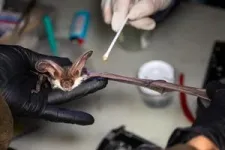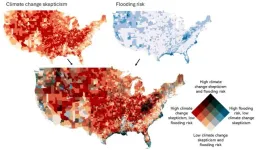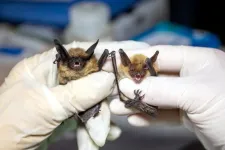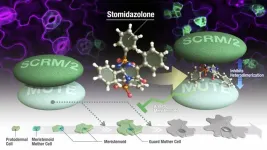(Press-News.org) Since its launch in late 2021, NASA’s James Webb Space Telescope has raised the possibility that we could detect signs of life on exoplanets, or planets outside our solar system.
Top candidates in this search are rocky, rather than gaseous, planets orbiting low-mass stars called M-dwarfs — easily the most common stars in the universe. One nearby M-dwarf is TRAPPIST-1, a star about 40 light years away that hosts a system of orbiting planets under intense scrutiny in the search for life on planets orbiting stars other than the sun.
Previous research questioned the habitability of planets orbiting TRAPPIST-1, finding that intense UV rays would burn away their surface water. That would leave the planet’s surface desiccated and, if only the hydrogen part of the water vapor molecules escapes, potentially with huge amounts of reactive oxygen that would inhibit origin-of-life chemistry.
Now, a University of Washington-led study recently published in Nature Communications finds that a sequence of events during the evolution of certain rocky planets orbiting M-dwarfs creates an atmosphere that would be stable over time.
“One of the most intriguing questions right now in exoplanet astronomy is: Can rocky planets orbiting M-dwarf stars maintain atmospheres that could support life?” said lead author Joshua Krissansen-Totton, a UW assistant professor of Earth and space sciences. “Our findings give reason to expect that some of these planets do have atmospheres, which significantly enhances the chances that these common planetary systems could support life.”
The James Webb Space Telescope is sensitive enough that it can observe a select few of these planetary systems. Data coming back so far suggests that the hottest rocky planets, closest to the TRAPPIST-1 star, do lack significant atmospheres. But the telescope has not yet been able to clearly characterize planets in the “Goldilocks zone,” slightly farther from their star, at a distance most favorable to supporting liquid water and life.
The new study modeled a rocky planet through the course of its molten formation and cooling over hundreds of millions of years into a solid terrestrial planet. Results showed that hydrogen or other light gases did initially escape into outer space. But for planets farther away from the star, where the temperature is more moderate, hydrogen also reacted with oxygen and iron in the planet’s interior. This produced water and other, heavier, gases, forming an atmosphere that results show is stable over time.
Results also showed that for these “Goldilocks zone” planets, water rains out of the atmosphere fairly quickly, making the water less likely to escape.
“It's easier for the JWST to observe hotter planets closest to the star because they emit more thermal radiation, which isn't as affected by the interference from the star. For those planets we have a fairly unambiguous answer: They don't have a thick atmosphere,” Krissansen-Totton said. “For me, this result is interesting because it suggests that the more temperate planets may have atmospheres and ought to be carefully scrutinized with telescopes, especially given their habitability potential.”
The JWST has not yet been able to see whether the planets a little farther from the TRAPPIST-1 star have atmospheres. But if they do, that means they could have surface liquid water and a temperate climate conducive to life.
“With the telescopes that we have now, the James Webb and the extremely large ground-based telescopes coming soon, we’re really only going to be able to look at a very small number of habitable zone rocky planets’ atmospheres — it’s the TRAPPIST-1 planets and a couple of others,” Krissansen-Totton said. “Given the huge interest in the search for life elsewhere, our result suggests that it’s worthwhile investing telescope time to continue studying the habitability of these systems with the technology we have now, rather than waiting for the next generation of more powerful telescopes.”
Co-authors are Nicholas Wogan, who did this work as a UW graduate student and is now at NASA; Maggie Thompson at Carnegie Institution for Science in Washington, D.C.; and Jonathan Fortney at the University of California, Santa Cruz. This research was supported by NASA.
END
Rocky planets orbiting small stars could have stable atmospheres needed to support life
2024-10-23
ELSE PRESS RELEASES FROM THIS DATE:
A 'worrying confluence' of flood risk, social vulnerability and climate change denial
2024-10-23
In certain parts of the United States, especially Appalachia, New England and the Northwest, the ability of residents to prepare for and respond to flooding is being undercut on three different levels.
This is according to a new study from the University of Michigan's School for Environment and Sustainability.
"It's a very worrying confluence that does keep me up," said Joshua Newell, a professor with the school's Center for Sustainable Systems and senior author of the study. "The communities that are most at risk of catastrophic flooding ...
Saving the bats: Researchers find bacteria, fungi on bat wings that could help fight deadly white-nose syndrome
2024-10-23
Saving the bats: Researchers find bacteria, fungi on bat wings that could help fight deadly white-nose syndrome
Hamilton, ON, Oct. 23, 2024 – Bacteria and fungi from the wings of bats could play a significant role in saving them from white-nose syndrome (WNS), a fungal disease affecting the skin of wings and muzzle, which has nearly wiped out vulnerable bat populations across North America.
Researchers at McMaster University have gathered and analyzed samples from the community of microorganisms, or microbiome, on the wings of several bat species ...
Project Cure CRC awards nearly $5 million in research funding
2024-10-23
Washington, D.C. – October 23, 2024 – Project Cure CRC, the breakthrough research fund of the leading nonprofit Colorectal Cancer Alliance (Alliance), has announced five new awardees of funds to advance urgent science in the colorectal cancer space. To date, 10 research grants have been awarded for a grand total of almost $5 million in critically needed funding.
Recipients of the most recent grants totaling almost $1 million include investigators from the University of California, San Francisco, Indiana University, University of Saskatchewan, Georgetown University, and Anglia Ruskin University. ...
New parasite discovered amid decline of California’s unique Channel Island fox
2024-10-23
California’s Channel Islands are home to the Channel Island fox (Urocyon littoralis), one of the smallest and most cherished species of island fox in the United States. Although no longer on the Endangered Species List, they remain a species of special concern due to their ecological importance.
In the 1990s, the San Miguel Island fox nearly went extinct, dropping to just 15 individuals. A recovery program restored their numbers by 2010. However, from 2014 to 2018, the population fell to 30% of its peak right after a new acanthocephalan parasite, commonly known as thorny-headed worms, was identified on the island. This also occurred while a multi-year draught heated San ...
Chemical Insights Research Institute publishes comprehensive guidance to protect community health impacted by wildland-urban interface fire events
2024-10-23
ATLANTA, Oct. 23, 2024 -- Chemical Insights Research Institute (CIRI) of UL Research Institutes has joined with UL Standards and Engagement to release new guidance for communities at risk for fires in wildland-urban interface (WUI) areas. An estimated 70,000 communities and 45 million residential buildings are at risk of destruction caused by wildfires. Additionally, WUI fires pose significant health risks. The smoke emitted by WUI fires likely contains a mixture of contaminants such as combustion gases, organic and inorganic metal complexes, volatile organic compounds and numerous reaction products. WUI wildfire plumes carry the risks of ...
New concussion sign identified by Mass General Brigham & Concussion Legacy Foundation scientists could identify up to 33% of undiagnosed concussions
2024-10-23
(Boston, MA) — Concussion researchers have recognized a new concussion sign that could identify up to 33% of undiagnosed concussions. After a hit to the head, individuals sometimes quickly shake their head back and forth. Although it has been depicted in movies, television, and even cartoons for decades, this motion has never been studied, named, and does not appear on any medical or sports organization’s list of potential concussion signs. A new study, led by Concussion Legacy Foundation (CLF) CEO and co-founder Chris Nowinski, PhD, says it should.
The study, published today in Diagnostics, reveals that when athletes exhibit this movement, ...
Dehydration linked to muscle cramps in IRONMAN triathletes
2024-10-23
PULLMAN, Wash. – As athletes prepare to dive into Hawaiian waters for the first part of the IRONMAN World Championship on Oct. 26, they may want to pay a little extra attention to the water inside their bodies.
Contrary to previous research, a Washington State University-led study of three decades of the IRONMAN’s top competition found a connection between dehydration and exercise-induced muscle cramps.
Based on medical data of more than 10,500 triathletes, the study, published in the Clinical Journal of Sport Medicine, found a strong link between dehydration and participants seeking treatment for muscle cramps during the competition. ...
Study: Marshes provide cost-effective coastal protection
2024-10-23
Images of coastal houses being carried off into the sea due to eroding coastlines and powerful storm surges are becoming more commonplace as climate change brings a rising sea level coupled with more powerful storms. In the U.S. alone, coastal storms caused $165 billion in losses in 2022.
Now, a study from MIT shows that protecting and enhancing salt marshes in front of protective seawalls can significantly help protect some coastlines, at a cost that makes this approach reasonable to implement.
The new findings are being reported in the journal Communications ...
New chemical treatment reduces number of plant pores that regulate water loss
2024-10-23
Researchers from Nagoya University Institute of Transformative Biomolecules (WPI-ITbM) in Japan and their colleagues have identified and derivatized a chemical compound that effectively regulates the density of stomata in model plants. Stomata are crucial for water regulation. As the environment grows increasingly unpredictable, managing water consumption for crops during droughts through chemical methods will become increasingly important. The results of their study were published in Nature Communications.
Manipulating protein interactions using chemical compounds is revolutionizing ...
Safety and security: Study shines light on factors behind refugees’ resilience
2024-10-23
“While exposure to persecution, war and displacement is associated with high rates of psychological disorders, such as PTSD and depression, remarkably the majority of refugees, despite having gone through very difficult experiences, don’t go on to develop a psychological disorder,” says Prof. Nickerson, Director of the Refugee Trauma and Recovery Program at UNSW’s School of Psychology.
Despite this, previous research has focused on trying to understand factors that predict psychopathology or psychological distress, rather than factors that ...







